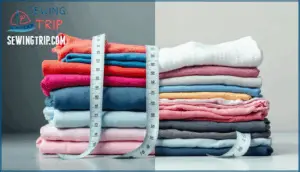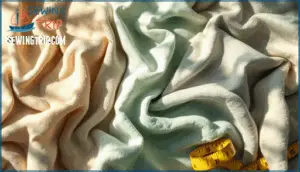This site is supported by our readers. We may earn a commission, at no cost to you, if you purchase through links.

Heat is the main culprit behind this contraction. When hot water or high dryer temperatures hit bamboo fibers, they tighten and compress. Understanding how bamboo reacts to water temperature, agitation, and drying methods helps you keep your clothes and bedding fitting properly for years.
The good news is that shrinkage is preventable when you know what causes it and how to adjust your care routine.
Table Of Contents
- Key Takeaways
- Does Bamboo Shrink?
- Why Does Bamboo Fabric Shrink?
- How Much Can Bamboo Shrink?
- Preventing Bamboo Shrinkage During Washing
- Proper Drying Methods for Bamboo
- Best Detergents and Laundry Products for Bamboo
- Storing Bamboo Clothing and Bedding Safely
- Bamboo Fabric Properties That Affect Shrinkage
- Frequently Asked Questions (FAQs)
- Conclusion
Key Takeaways
- Bamboo fabric shrinks 4-6% under standard washing conditions, primarily due to heat exposure from hot water above 40°C or high dryer temperatures, which causes fiber contraction and compression.
- Cold water (below 30°C), gentle wash cycles, and air drying are the most effective methods to prevent shrinkage while maintaining bamboo’s softness and dimensional stability at 95% of original size.
- Bamboo-spandex blends show less shrinkage (under 3%) than pure bamboo viscose, and proper care including mild pH-neutral detergents without fabric softeners extends fabric life to 3-5 years.
- Shrinkage occurs most dramatically during the first wash when manufacturing tension releases, but following proper care instructions prevents cumulative damage from repeated washing over time.
Does Bamboo Shrink?
Yes, bamboo fabric can shrink under certain conditions. How much it shrinks compared to other materials, when this usually happens, and what you might’ve heard that isn’t quite true all play a role in how you care for your bamboo items.
Let’s clear up the facts so you know exactly what to expect.
Shrinkage in Bamboo Fabric Vs. Other Materials
Regarding shrinkage, bamboo fabric behaves differently than other common textiles due to its unique fiber structure. Here’s how bamboo stacks up against other materials:
- Bamboo fabric: Shrinks 4–6% under standard washing, similar to viscose-based fibers
- Cotton shrinkage: Ranges from 3–7% depending on weave density and water temperature
- Linen contraction: Shows 4–10% shrinkage due to high cellulose crystallinity
- Wool felting: Displays 5–10% shrinkage from its scaly surface structure
- Silk stability: Minimal shrinkage at 2–5% thanks to less hygroscopic protein fibers
Bamboo’s multihole structure absorbs 40% more moisture than cotton, making it more susceptible to heat-induced contraction. Bamboo is also known for its natural anti-bacterial properties, which can be affected by washing.
Understanding these differences helps you prevent shrinkage and maintain your bamboo clothing’s fit.
Common Scenarios Where Shrinkage Occurs
Knowing where shrinkage happens helps you protect your bamboo items. Hot water above 40°C causes the most damage because it releases fiber tension and triggers 3–6% contraction in the first wash. Machine drying at high heat compounds this by adding mechanical stress that can shrink fabric by 5–10%. Washing with abrasive fabrics like jeans creates friction that distorts fibers. Sunlight exposure during drying accelerates moisture loss and adds 2–4% shrinkage. Moisture imbalance during manufacturing also sets the stage for later problems.
To best preserve bamboo clothing, consider using gentle, eco-friendly detergents.
Misconceptions About Bamboo Shrinkage
You might believe bamboo fabric shrinks more than cotton or needs special care products. That’s not accurate. Well-maintained bamboo viscose shrinks 3–5%, matching cotton’s 3–4% range.
High-quality bamboo retains over 90% of its strength after 50 washes below 40°C. You don’t need unique detergents either. Standard gentle-cycle washing prevents damage just like with cotton blends.
Durability myths label bamboo as delicate, but fiber testing proves otherwise. Shrinkage rates above 10% stem from heat exposure, not fabric weakness. Blend accuracy matters too—bamboo-spandex mixes actually shrink less than pure viscose due to synthetic stabilization.
Why Does Bamboo Fabric Shrink?
Bamboo fabric shrinks when certain conditions stress its fibers during care. Heat exposure stands out as the biggest culprit, but it’s not the only factor at play.
Let’s look at the three main reasons your bamboo clothing or bedding might shrink.
Effects of Heat on Bamboo Fibers
Heat acts like a stress test for bamboo fibers. When you expose them to high temperatures above 180°C, something interesting happens at the molecular level:
- Thermal Degradation begins around 220°C, breaking down cellulose and hemicellulose which normally give the fabric its strength
- Fiber Brittleness increases as hydrogen bonds weaken and the material shifts from flexible to rigid
- Moisture Influence plays a key role since bamboo loses water starting at just 30°C, altering fiber structure
These chemical changes reduce the fiber’s ability to absorb moisture while increasing its crystallinity.
The structural impact includes thinner fiber walls and more pores between cell layers. This combination of heat and moisture content shifts causes the shrinkage you see in your bamboo clothing.
Agitation and Mechanical Stress
Beyond the spin cycle, your washing machine puts bamboo through a physical workout that changes the fabric itself. Bamboo viscose fibers have weaker bonds than cotton, making them vulnerable to fiber damage during agitation.
Each laundry cycle creates yarn-level stress that causes the fibers to slip and compress. This mechanical action also initiates hygro-mechanical interaction, where moisture and movement combine to worsen shrinkage.
Your fabric can lose dimensional stability with repeated washing, but controlled action through gentle cycles lessens this effect considerably.
Changes in Moisture Content
Bamboo fabric shrinks because its moisture content shifts during washing and drying. When bamboo fibers absorb water they swell, then contract as they dry. This creates dimensional changes that shrink your garments.
- Bamboo absorbs 12-15% of its dry weight in water vapor at high humidity
- Desorption behavior shows hysteresis—fibers don’t return to their original size
- Mechanical properties weaken as moisture content increases, making fabric less stable
Humidity interaction during washing instructions affects how much your bamboo types shrink permanently.
How Much Can Bamboo Shrink?
Bamboo shrinkage isn’t a mystery once you understand the numbers. Different bamboo products shrink at different rates depending on how they’re made and how you care for them.
Let’s look at what you can expect from your bamboo clothing, bedding, and other items.
Typical Shrinkage Rates in Clothing
When you wash your favorite bamboo tee, expect around 4–6% shrinkage after a standard laundry cycle. That’s roughly half an inch per foot of fabric. Cotton shrinks similarly at 3–7%, but synthetic alternatives like polyester stay below 2%. Blending bamboo with spandex cuts shrinkage nearly in half. Pre-treatment effects also matter—fabrics treated with anti-shrink finishes show 40% less dimensional change.
Here’s how bamboo clothing compares:
| Fabric Type | Shrinkage Rate | Notes |
|---|---|---|
| Bamboo Viscose | 4–6% | Moderate; cold water helps |
| Cotton | 3–7% | Similar to bamboo |
| Linen | 4–10% | Higher shrinkage risk |
| Polyester | <2% | Best for preventing clothing shrinkage |
Viscose blends with synthetic alternatives reduce average shrinkage by 30–50%. That’s why bamboo fabric characteristics vary widely—check your garment’s blend before washing. Cotton differences aren’t huge, but linen comparisons show bamboo clothing performs better overall.
Shrinkage in Bamboo Sheets and Bedding
Your queen-size bamboo sheets can shrink up to 15% after repeated washing—that’s around two inches off each edge. Initial shrinkage hits hardest during the first wash when fibers relax from manufacturing tension. Heat treatment during drying accelerates fiber contraction, while humidity effects cause reversible swelling between washes.
Pre-shrinking treatments cut this dimensional change by half. Preventing bamboo sheet shrinkage means washing bamboo sheets in cold water and air drying. Caring for bamboo bedding properly extends its life considerably compared to standard bedding care methods.
Technical Shrinkage Data (Tangential, Radial, Longitudinal)
Your bamboo fabric experiences three distinct types of shrinkage. Tangential contraction rates range from 5.0% to 6.0%—the highest among all directions. Radial shrinkage factors fall between 4.4% and 5.1%, while longitudinal stability remains remarkable at just 0.6% to 1.1%.
Understanding these numbers helps with shrinkage prevention:
- Moisture content impact triggers contraction below 12% equilibrium moisture
- Heat treatment effects reduce tangential shrinkage from 5.8% down to 3.0%
- Washing and drying affect tangential dimensions most during bamboo fabric care
Preventing Bamboo Shrinkage During Washing
Washing bamboo fabric the right way keeps it from shrinking. The three most important steps involve controlling temperature, choosing the right wash cycle, and grouping your laundry carefully.
Here’s what you need to know to protect your bamboo items.
Choosing The Right Water Temperature
Water temperature matters more than most people realize. You should stick to cold water below 30°C (86°F) when washing bamboo fabric. Hot water above 40°C can cause up to 6% shrinkage and weaken fibers.
Most manufacturers recommend temperatures between 20-30°C to keep your bamboo items looking their best. Cold water preserves softness and prevents the fiber damage that leads to permanent shrinkage.
Selecting Gentle Wash Cycles
Your washing machine setting makes all the difference. Always choose the gentle or delicate cycle when washing bamboo clothing. These settings cut agitation by 25-35% compared to standard cycles, which helps bamboo viscose keep 90% of its strength instead of just 65%.
Gentle cycles also reduce shrinkage from 5-10% down to only 2-3%. Look for slower spin speeds between 400-800 RPM and keep total cycle times under 45 minutes to protect the fibers.
Washing With Similar Fabrics
You’ll also want to separate your bamboo fabric from heavier materials during laundry. Mixing bamboo with denim or towels increases fiber abrasion by 8% and boosts microfibre release by 12%.
Stick with lightweight fabrics like cotton to cut shrinkage by up to 10%. This protects dimensional stability and prevents fabric pilling rates from jumping 2-3 times higher.
Keep zippers and buttons away too—they cause 15% more structural damage to bamboo’s delicate fibers.
Proper Drying Methods for Bamboo
How you dry your bamboo items matters just as much as how you wash them. The drying method you choose can be the difference between keeping your bamboo soft and fresh or dealing with unwanted shrinkage.
Let’s look at the best ways to dry bamboo so it stays in great shape.
Air Drying Vs. Machine Drying
When you choose between drying methods, air drying stands out as the clear winner for bamboo. It maintains fiber integrity and dimensional stability far better than machine drying.
Tests show air-dried bamboo keeps 95% of its original size, while tumble drying at high temperatures causes 3–5% shrinkage. Air drying also preserves softness retention by 8–10% and cuts energy consumption to zero, saving you money while protecting your bamboo from unnecessary wear.
Risks of Excessive Heat Exposure
High temperatures push bamboo fibers past their tolerance threshold. When you expose your bamboo fabric to heat above 160°C, the fibers start breaking down at the molecular level.
Consider what happens during excessive heat exposure:
- Fiber degradation: Tensile strength drops while brittleness increases, making your clothing prone to tears
- Moisture loss: Rapid water evaporation causes dimensional changes and permanent shrinkage of 5–10%
- Chemical alterations: Cellulose and hemicellulose degrade, weakening the fabric structure
Your dryer’s high-heat setting accelerates this damage, reducing your bamboo’s product lifespan considerably.
Best Practices for Drying Bamboo Clothing and Sheets
How do you protect your bamboo items during drying? Air drying preserves up to 90% of fiber integrity and prevents shrinkage better than any machine method. Hang dry indoors in a shaded spot with good airflow to maintain dimensional stability within 1% of the original size.
If you use a dryer, choose low heat settings below 40°C and remove items while slightly damp. This hybrid approach cuts wrinkle formation by 40% while supporting long-term durability across 110-plus wash cycles.
Best Detergents and Laundry Products for Bamboo
Choosing the right laundry products makes all the difference in keeping your bamboo fabric in great shape. The wrong detergents or additives can damage fibers and cause unwanted shrinkage.
Let’s look at what works best for bamboo and what you should avoid.
Suitable Detergents for Bamboo Fabric
You can protect your bamboo pieces by using the right detergent. Mild detergent with neutral pH between 6.5 and 7.5 keeps fibers stable and reduces shrinkage by up to 18%. Plant-based formulas maintain fiber strength 20% longer than normal detergent after repeated washes.
Eco-friendly options work best:
- Ecos or Seventh Generation for gentle cleaning
- Meyer’s Clean Day or Aspen Clean for fragrance-free detergent needs
- Dreft or Attitude for baby clothing
Choosing the right detergent means avoiding harsh chemicals like phosphates and optical brighteners. Pair your mild detergent with cold water temperature between 30°C and 40°C for maximum protection.
Avoiding Fabric Softeners and Additives
Fabric softener damages bamboo fibers through coating buildup. This residue reduces breathability by 30% and moisture absorption by up to 40%. Softener residue weakens blend compatibility in bamboo-spandex mixes and causes chemical damage that increases shrinkage.
Skip fabric softeners entirely for shrinkage prevention. Natural alternatives like white vinegar or baking soda soften bamboo during washing without compromising your laundry routine.
Tips for Stain Removal
Stains need immediate action to avoid permanent marks. Blot spills right away with a clean cloth instead of rubbing.
Cold water rinse works for most fresh stains on bamboo bedding and clothing. Enzyme treatments handle sweat and blood effectively. Oil stains respond to dish soap or white vinegar solution. Baking soda paste lifts food marks before washing.
Always test stain removal products on hidden fabric areas first for stain prevention.
Storing Bamboo Clothing and Bedding Safely
Proper storage protects your bamboo items from unnecessary wear and keeps them fresh between uses. The way you store these pieces directly affects how long they maintain their shape and softness.
Let’s look at three key storage practices that prevent shrinkage and extend the life of your bamboo clothing and bedding.
Preventing Moisture Buildup
To keep moisture away from stored bamboo bedding and pillowcases, store bamboo sheets at relative humidity below 60% to minimize mildew formation. Use open shelving instead of sealed plastic containers to maintain airflow importance.
Fold your duvet covers properly along the grain right after drying to reduce trapped moisture by 28%.
Check stored items every two weeks as part of your monitoring strategies to catch early signs of dampness and prevent mold growth.
Avoiding Direct Sunlight and Heat Sources
Storing bamboo fabric away from windows and radiators prevents UV Fiber Damage and Thermal Degradation. Direct sunlight triggers Sunlight Discoloration within 20 hours and weakens fiber elasticity. Heat Source Proximity above 180°F degrades cellulose and causes shrinkage prevention failures.
Your Storage Environment should stay cool and dark. Avoid drying methods using high temperatures near heat vents. Instead, hang items on a clothesline in shaded areas to maintain bamboo fabric integrity.
Storage Tips for Longevity
Beyond light and heat protection, humidity control and temperature regulation form the foundation of proper storage for bamboo sheets and clothing. Your bamboo items stay strongest when you maintain 50–60% relative humidity and temperatures between 68–77°F. That’s why material protection matters for bedding longevity.
Here’s how to extend the life of bedding with proper care for bamboo sheets:
- Fold instead of hang to prevent stretching and mechanical stress on bamboo fabric
- Add desiccant packets to lower moisture levels by 10–15% and block mildew formation
- Store in breathable cotton bags to allow continuous air exchange and moisture prevention
- Inspect every 3–6 months to catch early signs of dampness or damage
Proper storage of bed sheets in well-ventilated closets with duration maintenance practices keeps your bamboo textiles strong for over a year.
Bamboo Fabric Properties That Affect Shrinkage
Not all bamboo fabric is created equal. The type of blend and how it’s made can change how much your bamboo items shrink over time.
Understanding these differences helps you know what to expect from your bamboo clothing and bedding.
Blend Types (e.g., Viscose, Spandex Mixes)
Bamboo clothing affects shrinkage prevention considerably. Viscose blend shrinkage usually ranges from 4–6% under standard washing conditions. Adding spandex elasticity shows benefits—bamboo-spandex mixes with 2–5% spandex exhibit less than 3% dimensional change after multiple washes.
Cotton blend resistance improves stability, with bamboo-cotton fabrics shrinking 2–3% less than pure cotton at 60°C. Polyester mix stability is excellent—bamboo-polyester blends show under 3% shrinkage due to polyester’s low moisture absorption.
Fiber processing influence matters too; mechanically processed bamboo viscose limits shrinkage to under 4% compared to chemically processed versions.
Impact of Manufacturing Methods
Fiber extraction methods greatly affect shrinkage rates. Chemical solvents in the viscose process remove lignin and hemicellulose but cause 10–15% fiber contraction when exposed to heat. Closed-loop systems like Lyocell recover over 99% of solvents and stabilize fiber structure.
Heat treatments between 150–200°C increase modulus but reduce moisture retention by 30%. Controlled drying methodologies at 80°C cut tangential shrinkage by 18%.
Resin integration in bamboo fabric production methods drops water absorption from 14.5% to 8.2%, improving dimensional stability in rayon fibers through better shrinkage prevention.
Durability and Dimensional Stability
Proper care extends fiber lifespan to 3–5 years. Bamboo’s natural strength resists pilling and bacterial degradation better than cotton. Elastic recovery allows fabric to bounce back up to 3% after washing. Shape retention stays strong even after 20 wash cycles with less than 3% dimensional change.
These fabric properties make bamboo durable when you follow washing guidelines and drying methods. Your garments keep their fit longer when you protect them from heat during care.
Frequently Asked Questions (FAQs)
Can you put bamboo clothing in the dryer?
High heat in the dryer can shrink bamboo fabric by over 5%, especially with extended exposure. You can use a dryer on the lowest heat setting or air-dry mode, but air drying is best to prevent shrinkage and fiber damage while preserving softness.
How do you get wrinkles out of bamboo sheets?
Removing wrinkles from bamboo sheets doesn’t require much effort. The best approach is pulling sheets out of the dryer while slightly damp and smoothing them by hand. Steaming sheets works well for stubborn creases. Ironing bamboo on low heat is safe if needed.
Proper drying techniques and storage solutions prevent most wrinkles naturally.
Does bamboo fabric keep you cool?
Yes, bamboo fabric keeps you cool. Its hollow fiber structure and micro-gaps improve air permeability and moisture-wicking properties, allowing the breathable fabric to draw sweat away from your skin and promote rapid evaporation for a cooling sensation.
Is bamboo clothing good for sensitive skin?
Bamboo clothing offers excellent relief for sensitive skin. The fabric’s hypoallergenic properties naturally resist bacteria and allergens.
Its tactile softness and moisture-wicking abilities keep skin dry and comfortable, reducing skin irritation that often triggers eczema flare-ups.
How long does bamboo fabric last compared to cotton?
With proper fabric care, bamboo generally lasts 2 to 5 years, while cotton can exceed 70 years. Bamboo fiber breakdown occurs faster despite greater wear resistance and shrinkage prevention.
Lifespan factors include washing temperature and detergent choice affecting durability differences.
Can bamboo fabric be ironed or steamed safely?
Think of heat and bamboo fabric like walking on thin ice—proceed with caution.
You can safely iron bamboo between 110°C and 130°C using low heat without steam. Steaming works too if you keep temperatures below 200°C and hold the steamer a few inches away. Both methods protect fibers from damage when done correctly.
Does bamboo shrink more than once over time?
If you don’t follow proper washing guidelines and drying methods, cumulative shrinkage can happen. Repeated washing in hot water and high-heat drying accelerates fiber fatigue.
Manufacturing impact matters too—some treatments improve long-term stability and shrinkage prevention for bamboo fabric.
How does bamboo compare to linen for shrinkage?
Both fabrics shrink at similar rates. Bamboo fabric generally contracts 3-5%, while linen averages 3-10%. Heat triggers shrinkage in both, especially above 30°C.
Proper washing guidelines and air drying methods prevent damage effectively.
Can you unshrink bamboo clothing after washing mistakes?
You can sometimes restore shrunken bamboo garments using stretching techniques and fabric relaxants. Soak the garment in lukewarm water with conditioner to relax fibers, then gently stretch while damp.
However, restoration limits exist—severe fiber damage or irreversible shrinkage from excessive heat may prevent full recovery.
Conclusion
Your bamboo fabrics will last longer when you treat them right. Does bamboo shrink? Yes, but only when exposed to conditions that stress the fibers.
Cold water protects against heat damage. Gentle cycles prevent mechanical wear. Air drying eliminates the biggest risk entirely. These simple adjustments transform your laundry routine from a gamble into a system that works every time.
Your bamboo clothes and bedding will keep their original fit for years instead of tightening after a few washes.
- https://www.wood-database.com/bamboo/
- https://bioresources.cnr.ncsu.edu/wp-content/uploads/2024/12/BioRes_20_1_Zhu_Review_Progress_Dry_Shrinkage_Deform_Drying_Stress_Bamboo_24099.pdf
- https://www.sciencedirect.com/science/article/abs/pii/S0926669022017150
- https://thebamboobear.com/do-bamboo-sheets-shrink/
- https://pmc.ncbi.nlm.nih.gov/articles/PMC12156455/















